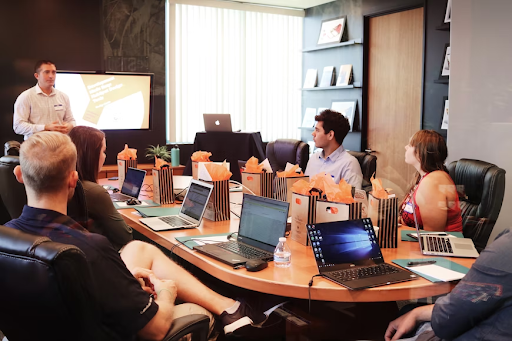This article will focus on explaining the intricacies of product research and development. We will try our best to explain these two terms, why they are of paramount importance, and how much budget you should allocate for product research and development.
These are two very broad terms that have very different meanings from each other, but are still as important as can be. Let’s approach this directly and start with definitions.
Table of Contents
What is product research and development (R&D)?
Product research and development is the name of taking action on research how your product differs from your competitorswhat can be done to make the product better, and to study the market in which you plan to sell your product.
It includes a set of activities that will help you better understand the benefits of the product, determine its advantages and competitiveness in the market.
The difference between them lies in the timing of the terms. Research is usually carried out before the launch of the actual product, and product development is carried out after the conceptual phase of the product is completed. Recently, however, the distinction has become somewhat blurred, with many researchers advocating the use of research even after the concept phase.
Why is research and development important?
We could spend hours on this topic, but let’s boil it down to three important elements where your product can benefit from well-done research.
Market
With proper market research, you can determine what you want to build on when selling a product. Different markets have different needs, and you won’t take the same approach to a well developed Western market with great commercial potential and a less developed African market. But you get the point, when the proper research is done, you will know what needs the product should satisfy, and then adapt your strategy accordingly.
Product
Will someone use the product? Is your product good enough to enter the market? Does it meet all legal requirements? Without prior research, you will not be able to answer these questions. And if these questions remain unanswered, there may be difficulties along the way, delaying the process of releasing a product or selling it. We all know that time is money, and while you may have to invest a little more in research, it can be of great benefit to you in the long run.
Brand
With well-done research, you can focus on creating a good brand experience. Good brand engagement means very easy and more importantly free word of mouth marketing. When your brand has a high reputation among your customers, they are more likely to buy again and, as an added bonus, tell their friends, colleagues, or loved ones about your brand. A good brand impression means loyal customers.
If, for example, you were supposed to buy something that you need and it is exactly what you are looking for, but there are problems in the process of buying this product, whether it is a long delivery time, a bad website experience, or something or else. obstacles, you will most likely switch to a competitor and tell your friends not to buy a product on their website as you had a bad experience when shopping there.
How much of the price of a product should go to research and development?
There are many variables when it comes to determining the right amount of money to spend on research and development. First the variable is the industry you work in.
Based data published in 2015, consumer non-durables (23% of the total), media and entertainment (15% of the total) and pharmaceuticals (13% of the total) spend the most on research. If you need more information, please refer to the table below.
Companies spend billions of dollars on research and development. For example, in 2021, Amazon spent $42.74 billion on research alone. Revenue for 2021 is $469.82 billion. It means that Amazon spends about 9% of its money on research alone. This figure only says that Amazon thinks it is right to spend almost 10% of its income on what may seem like a trifle in the eyes of others.
As stated earlier, there are many variables when setting a budget for product research and development. Find statistics for your industry and try to adjust your budget accordingly. R&D spending should not be static. When you develop a new product, your research budget should also reflect this.
It is important to note that you do not stop funding research after a product is released to the market. Markets are volatile – they change and you don’t want to sleep through some major changes just because you haven’t paid enough attention to the research aspect.
Research and development process
To make things easier, we will go through the R&D process step by step, with the individual steps as broad as possible so that you can tailor it to your product accordingly.
1. Sit down and talk
The first step in the process is to sit down and brainstorm. Let your team go crazy with ideas, and one of them may be destined to be the one that actually comes to fruition. Remember to also do some research first so that employees have a general idea of what you would like to add to your product line.
2. Do market research
Once you have selected your ideas, be sure to ask the public what they think of this potential product that will hit the market. You may think that the product you are bringing to market is innovative, but the general public may have a different view. Once your research data is collected and sorted, you can make changes to the product that will make it available to more people, so more people will consider buying it.
If the first idea doesn’t work, try to improve it with the information from the research and take it to the streets again. If the public still doesn’t approve of the product, rinse and repeat until they approve of your idea.

3. Bring ideas to life
By looking at the results of the research and having a thorough conversation with the general public about the design and the product itself, you should become more confident about the product’s message and purpose.
After you are happy with the product, get to work – sketch out its appearance and create a prototype. (Don’t forget about upfront research, which can save you money and time in further product development. Make sure your design decisions are informed and backed up by prior data!)
4. Test and tune the prototype
After your product is assembled and the first designs are created, test your prototype using one of the online services. usability testing tools to see if everything is working as intended.
This can make all the difference and save you money later on as you would find most of the concept, design, etc. errors in the first prototype.
5. Rinse and repeat until you are sure the prototype is well received.
This stage is very important in creating a new product. You must take into account all the mistakes you made and discovered during the research. Get rid of the negatives and focus on your customers and how they will benefit from the product. If you don’t, your product may be exposed to the harsh reality of an already oversaturated market.
6. Take everything that’s been said about a product and release it
Once you have confidence in the look, feel, function, and other factors of a product, you can proceed to bring it to market.
Using research and development (R&D) to avoid creating useless products

Only the market itself decides what is ripe for release and what is too ahead of its time. Let’s take a quick look at some of the tips to keep in mind when building a product. This way you can be sure that it is not released too far ahead.
Market research
Conducting market research will greatly simplify decision making. You can hear for yourself what the general public thinks about your product.
If the people you interviewed were adamant that the product is currently worthless, don’t abandon it. Maybe just ask them what would make them change their mind. This is a very theoretical question. But even with vague answers, you feel the best time to release a product.
Follow the trends
Look at the trends that are happening around you and pay attention to them. If there is a trend in your industry, see what it is. Try to figure out how to implement this in your product. If the trend is to use social media as a platform to promote your product, consider using this type of marketing to your advantage. This will help you stay ahead of your competitors.
Determine how your product is useful
Try to identify the advantages and disadvantages of your product and find a way to make it popular. All this while also taking into account its usefulness at any given time. Your product may not be very user-friendly right now, but in two years it could become a popular trend.
This will mean that you have two extra years to prepare for this moment and release one of the best products on the market, with well-done research and usability at its best.
Product research and development: not to be underestimated
As we established earlier, product development and research should not be underestimated. The constant pressure to make things cheaper and faster makes it hard to keep control of the situation you’re in right now. But good research is an investment in the future. If the research is successful and the requested changes are implemented correctly, it can save you thousands if not millions of dollars in further product development.
It might be cheaper to skip the research and go straight to the prototyping stage. But it will be much more expensive to correct errors that you might have found out about if the research had been done properly.






































